A bad case of the 'Nineties
By Colin Twiggs
August 23rd, 2015 3:00 p.m. AET (1:00 a.m. EDT)
Advice herein is provided for the general information of readers and does not have regard to any particular person's investment objectives, financial situation or needs. Accordingly, no reader should act on the basis of any information contained herein without first having consulted a suitably qualified financial advisor.
The 1990s featured two significant upheavals in global financial markets. First, 1990 saw the Nikkei collapse from its high of 39000, reaching an eventual low of 7000 in 2008.
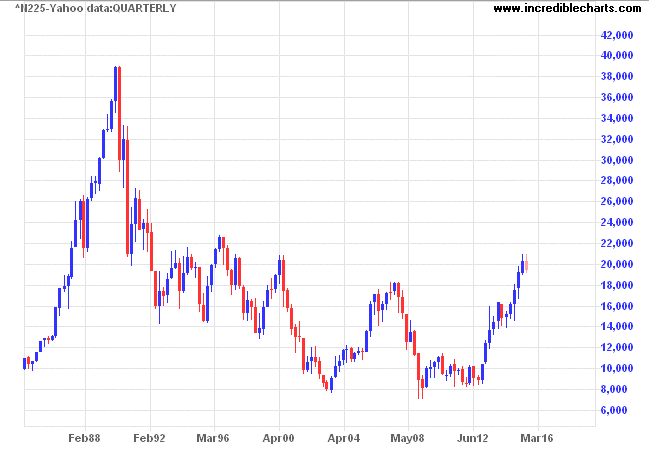
The collapse followed strong appreciation of the Yen after the September 1985 Plaza Accord and the ensuing October 1987 global stock market crash. The Plaza Accord attempted to curtail long-term currency manipulation by Japan who had built up foreign reserves — mainly through purchases of US Treasuries — to suppress appreciation of the Yen against the Dollar and maintain a current account surplus.
Seven years later, collapsing currencies during the 1997 Asian financial crisis destroyed fast-growing economies — with Thailand, South Korea and Indonesia experiencing 40%, 34% and 83% falls in (1998) GNP respectively — and eventually led to the 1998 Russian default and break up of the Soviet Union. Earlier, rapidly growing exports with currencies pegged to the Dollar brought a flood of offshore investment and easy credit into the Asian tigers. Attempts by the IMF to impose discipline and a string of bankruptcies spooked investors into a stampede for the exits. Falling exchange rates caused by the stampede led to a further spate of bankruptcies as domestic values of dollar-denominated debt skyrocketed. Attempts by central banks to shore up their currencies through raising interest rates failed to stem the outflow and further exacerbated the disaster, causing even more bankruptcies, with borrowers unable to meet higher interest charges.
What we are witnessing is a repeat of the nineties. This time it was China that attempted to ride the dragon, pegging its currency against the Dollar and amassing vast foreign reserves in order to suppress appreciation of the Yuan and boost exports. The Chinese economy benefited enormously from the vast trade surplus with the US, but those who live by the dragon die by the dragon. Restrictions on capital inflows into China may dampen the reaction, compared to the 1997 crisis, but are unlikely to negate it. The market will have its way.
Financial markets in the West are cushioned by floating exchange rates which act as an important shock-absorber against fluctuations in financial markets. The S&P 500 fell 13.5% in 1990 but only 3.5% in October 1997. The ensuing collapse of the ruble and failure of LTCM, however, caused another fall of 9.0% a year later. Not exactly a crisis, but unpleasant all the same.
North America
The domestic US economy slowed in the past few months but increased spending on light motor vehicles and housing suggested that robust employment growth would continue. Upheaval in financial markets (and exports) now appears likely to negate this, leading to a global market down-turn.
The S&P 500 breached primary support at 1980, signaling a primary down-trend. The index has fallen 4.5% from its earlier high and presents a medium-term target of 1830*. Decline of 13-week Twiggs Money Flow below zero would confirm the signal but descent has been gradual, suggesting medium-rather than long-term selling pressure.
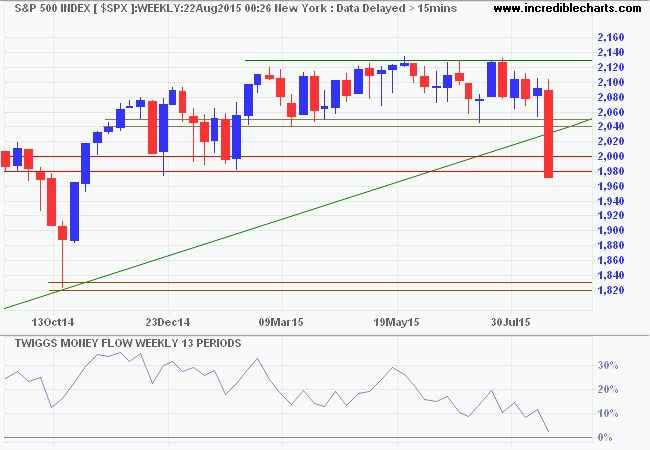
* Target calculation: 1980 + ( 2130 - 1980 ) = 1830
The CBOE Volatility Index (VIX) spiked upwards indicating rising market risk.
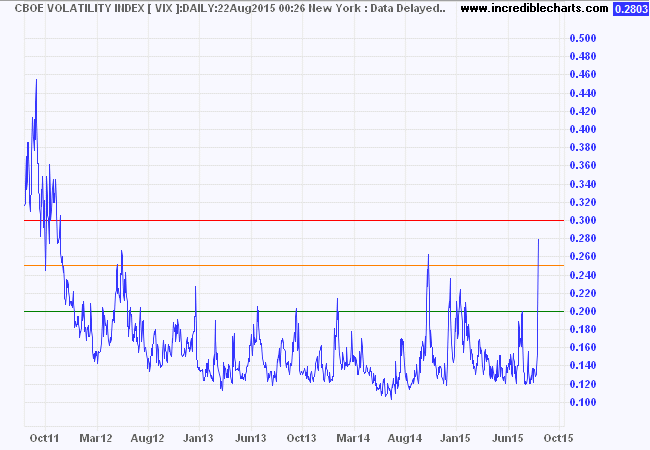
Bellwether transport stock Fedex broke primary support at $164, confirming the primary down-trend signaled by 13-week Twiggs Money Flow reversal below zero. The fall warns of declining economic activity.
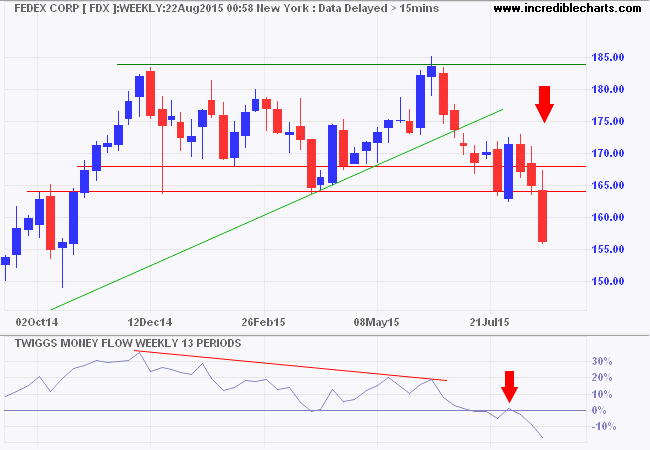
Canada's TSX 60 broke primary support at 800, confirming the earlier bear signal from 13-week Twiggs Momentum reversal below zero. Target for a decline is 700*.
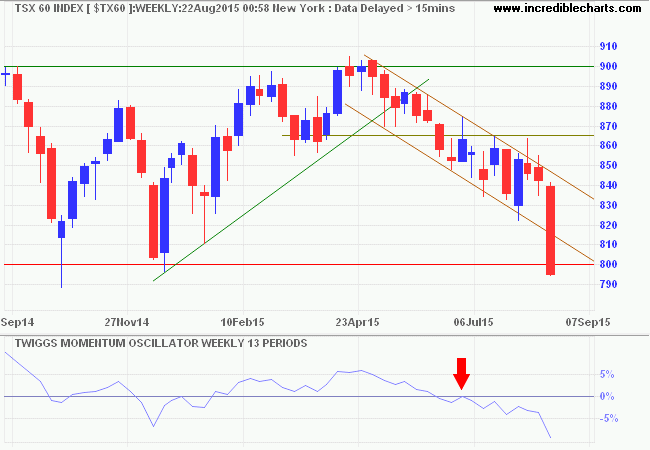
* Target calculation: 800 - ( 900 - 800 ) = 700
Europe selling
Germany's DAX broke medium-term support at 10700. Expect further medium-term support at 10000 but reversal of 13-week Twiggs Money Flow below zero warns of selling pressure. Breach of 10000 would indicate a test of primary support at 9000.
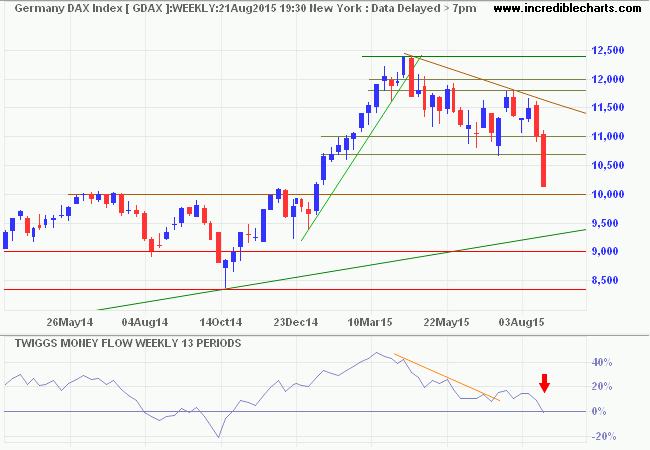
* Target calculation: 10700 - ( 11800 - 10700 ) = 9600
The Footsie broke 6450, signaling a test of primary support at 6100. Reversal of 13-week Twiggs Money Flow below zero warns of (long-term) selling pressure. Breach of 6100 would offer a target of 5000**.
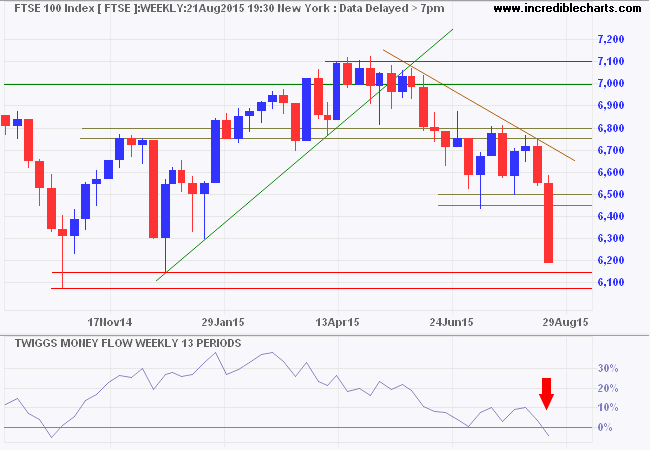
* Target calculation: 6450 - ( 6800 - 6450 ) = 6100 **Long-term: 6000 - ( 7000 - 6000 ) = 5000
Asia
The Shanghai Composite reflects artificial, state-backed support at 3500. Declining 13-week Twiggs Money Flow warns of long-term selling pressure. Withdrawal of government support is unlikely, but breach of 3400/3500 would cause a nineties-style collapse in stock prices.
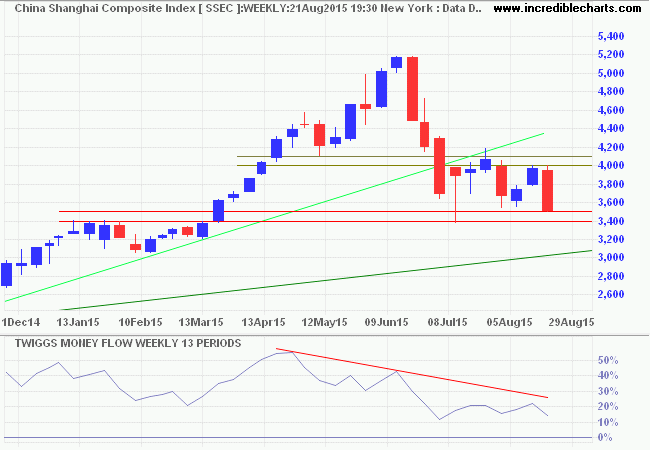
* Target calculation: 4000 - ( 5000 - 4000 ) = 3000
Japan's Nikkei 225 appears headed for a test of 19000. Breach would test primary support at 17000 but, given the scale of BOJ easing, respect is as likely and would indicate further consolidation between 19000 and 21000. Gradual decline of 13-week Twiggs Money Flow suggests medium-term selling pressure.
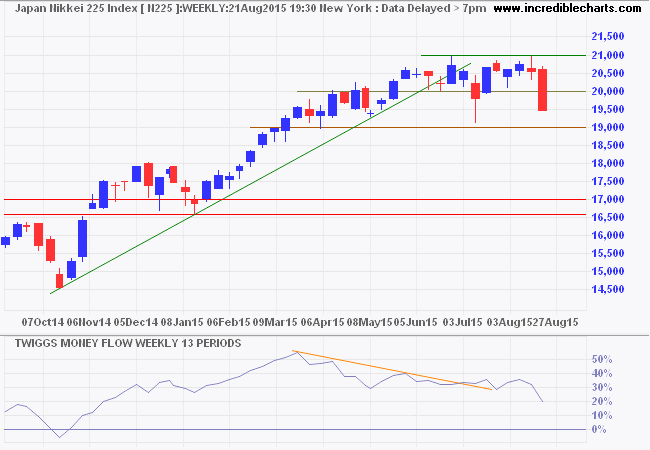
* Target calculation: 21000 + ( 21000 - 19000 ) = 23000
India's Sensex is holding up well, with rising 13-week Twiggs Money Flow signaling medium-term buying pressure. Breakout above 28500 is unlikely but would indicate another test of 30000. Decline below 27000 would warn of a primary down-trend; confirmed if there is follow-through below 26500.
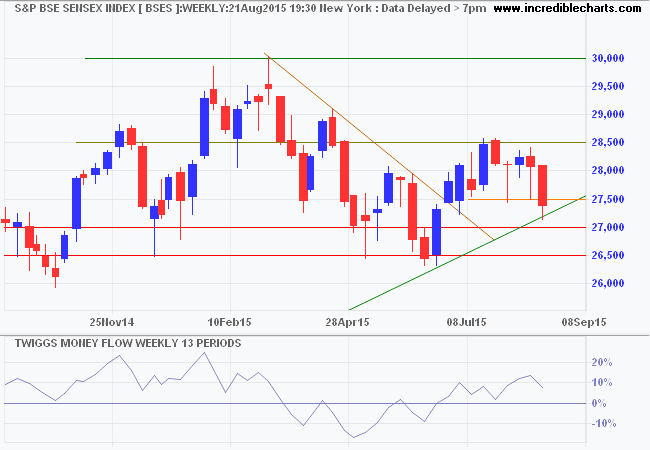
Australia
Commodity-rich Australian stocks are exposed to China and emerging markets. The only protection is the floating exchange rate which is likely to adjust downward to absorb the shock — as it did during the 1997 Asian crisis. 13-Week Twiggs Money Flow below zero warns of (long-term) selling pressure on the ASX 200. Breach of support at 5150 is likely and would confirm a primary down-trend. Long-term target for the decline is 4400*. Respect of primary support is unlikely, but would indicate consolidation above the support level rather than a rally.
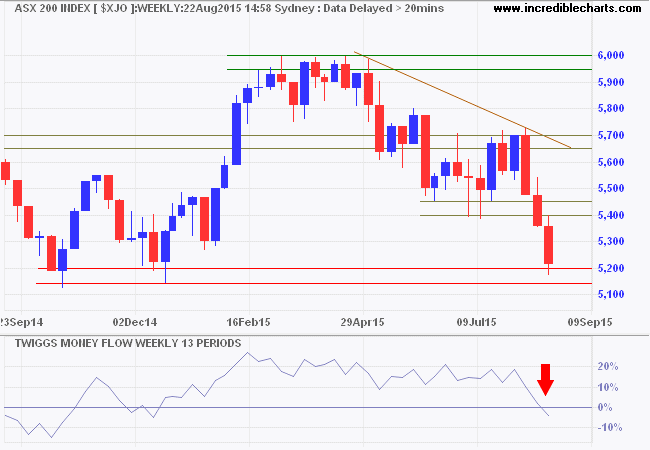
We live in a global economy, but the political organization of our global society is woefully inadequate. We are bereft of the capacity to preserve peace and to counteract the excesses of the financial markets. Without these controls, the global economy is liable to break down....
~ George Soros: The Crisis of Global Capitalism (1998)
Disclaimer
Research & Investment Pty Ltd is a Corporate Authorized Representative (AR Number 384 397) of Andika Pty Ltd which holds an Australian Financial Services Licence (AFSL 297069).
The information on this web site and in the newsletters is general in nature and does not consider your personal circumstances. Please contact your professional financial adviser for advice tailored to your needs.
Research & Investment Pty Ltd ("R&I") has made every effort to ensure the reliability of the views and recommendations expressed in the reports published on its websites and newsletters. Our research is based upon information known to us or which was obtained from sources which we believe to be reliable and accurate.
No guarantee as to the capital value of investments, nor future returns are made by R&I. Neither R&I nor its employees make any representation, warranty or guarantee that the information provided is complete, accurate, current or reliable.
You are under no obligation to use these services and should always compare financial services/products to find one which best meets your personal objectives, financial situation or needs.
To the extent permitted by law, R&I and its employees, agents and authorised representatives exclude all liability for any loss or damage (including indirect, special or consequential loss or damage) arising from the use of, or reliance on, any information. If the law prohibits the exclusion of such liability, such liability shall be limited, to the extent permitted by law, to the resupply of the said information or the cost of the said resupply.
Important Warning About Simulated Results
Research & Investment (R&I) specialise in developing, testing and researching investment strategies and systems. Within the R&I web site and newsletters, you will find information about investment strategies and their performance. It is important that you understand that results from R&I research are simulated and not actual results.
No representation is made that any investor will or is likely to achieve profits or losses similar to those shown.
Simulated performance results are generally prepared with the benefit of hindsight and do not involve financial risk. No modeling can completely account for the impact of financial risk in actual investment. Account size, brokerage and slippage may also diverge from simulated results. Numerous other factors related to the markets in general or to the implementation of any specific investment system cannot be fully accounted for in the preparation of simulated performance results and may adversely affect actual investment results.
To the extent permitted by law, R&I and its employees, agents and authorised representatives exclude all liability for any loss or damage (including indirect, special or consequential loss or damage) arising from the use of, or reliance on, any information offered by R&I whether or not caused by any negligent act or omission.
